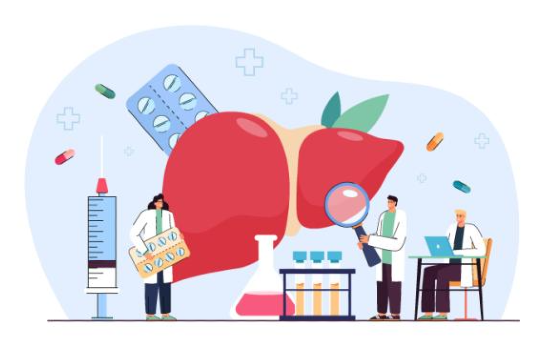Hepatitis D
Hepatitis D is a viral infectious disease caused by the Hepatitis D Virus (HDV) that affects the liver and disturbs its daily activities. It causes severe damage and inflammation of the liver by attacking the liver cells.
Hepatitis D requires pre-existing Hepatitis B virus (HBV) infection for attacking an individual. A combined attack of HBV and HDV causes severe liver damage and inflammation of the liver tissues leading to a number of chronic liver diseases like liver cirrhosis, liver failure, and liver cancer. It is possible that both the virus attack a person at the same time, thus infecting with Hepatitis B and Hepatitis D infection.
One can also get affected with Hepatitis D if they already have or had a chronic Hepatitis B infection. Hepatitis D spreads in a similar way to that of Hepatitis B which is via coming in contact with the body fluids of an infected person such as blood, saliva, semen, etc. It can infect anyone including children and infants during birth, however, those instances are rare, but adults are at a greater risk.
Currently, there is no effective vaccine available for Hepatitis D specifically. But in order to prevent and protect from HDV infection, it is important to get vaccinated against the Hepatitis B virus. The Hepatitis B virus vaccine is available with 90% protection against the virus.
How common is the Hepatitis D virus?
The occurrence of Hepatitis D infection can be observed in regions where the Hepatitis B infection rate is high. According to a report by the World Health Organization (WHO), Hepatitis B is a very common infection that spreads easily among people without showing clear signs of infection, thus infecting about 1 in 3 individuals worldwide while the prevalence of Hepatitis D is only 5% globally.
The chances of Hepatitis D infection after contracting Hepatitis B infection are common and occur in about more than 50% of cases. Relapsing of both infections was also observed in a few cases. Along with this, the occurrence of both the infection at the same time is also possible and life-threatening.
Adults are the major source of infection and young children are at a greater threat of spreading it unknowingly as HBV doesn’t show any symptoms until 6 months after infection. Also, children have better and stronger immunity than adults which helps them in overcoming the infection before it turns into a serious chronic one.
The combined infection of Hepatitis B and D are considered to be a more life-threatening form of viral hepatitis as it leads to chronic diseases like liver cirrhosis, liver failure, liver cancer, and may even lead to the death of the patient.
How does the Hepatitis D virus spread?
It spreads in a similar fashion to Hepatitis B. it is a highly contagious disease that affects everyone, from infants to adults, and the only way to get immunity against it is HBV vaccination which is 90% effective.
It spreads in the following ways:
-
Via body fluids like blood, semen, saliva,
-
Broken skin
-
Tattooing
-
Injections
-
From mother to child
-
Hepatitis C infected individual
-
HIV-infected individual
-
Recipients of hemodialysis
-
Men who have sex with men
-
Commercial sex workers
Who is at risk of developing Hepatitis D infection?
Everyone is at risk from young children to adults. Since the infection rate of Hepatitis B is high in children, they are potential carriers and might infect a number of adults before completely recovering from it.
Adults on the other hand get infected with Hepatitis B as well as D and recover if it’s an acute infection or develops a chronic infection that causes permanent liver damage.
The cases of relapsing of either or both of the types of hepatitis are very common and require medical attention before it turns life-threatening.
What are the symptoms of the Hepatitis D virus?
As Hepatitis D is caused because of Hepatitis B, it shows very similar symptoms. Most Hepatitis B patients are asymptomatic in the initial 2 to 6 months of infection.
After 6 months of infections people with acute Hepatitis B show the following symptoms that are also an indicator of Hepatitis D infection:
-
Feeling tired all the time
-
General feeling of being unwell
-
Joint and muscle pain
-
Loss of appetite
-
Raised temperature
-
Weight-loss
-
Fever
-
Nausea
-
Vomiting
-
Pain in the upper part of the abdomen
-
Swelling of the abdomen
-
Swelling of ankles
-
Itching skin
-
Dark yellow urine
-
Pale stools
-
Jaundice (yellowing of skin and eyes)
What can help against Hepatitis D Virus?
At present, there is no proven treatment for Hepatitis D infection except for being vaccinated for Hepatitis B infection. In certain cases, the chances of HDV and HBV infection relapsing are recorded which makes the infected person weaker and more susceptible to developing chronic liver failure.
In conditions like this, it is advised to take proper rest and practice safe and hygienic activities to reduce the infection rate.
AFD Pharma's Livocumin liver tablets are the best ayurvedic liver supplements that help in protecting the liver against a large number of liver disorders like fatty liver disease, jaundice, gall stones, and viral hepatitis types like Hepatitis A, B, C, D, and E.
Livocumin is a liver tonic that possesses hepato-protective, antioxidant, and anti-inflammatory properties by protecting, detoxifying, repairing, and strengthening the liver. The all-natural formulation of Livocumin makes it a reliable ayurvedic liver medicine that aids the detoxification processes of the liver.
